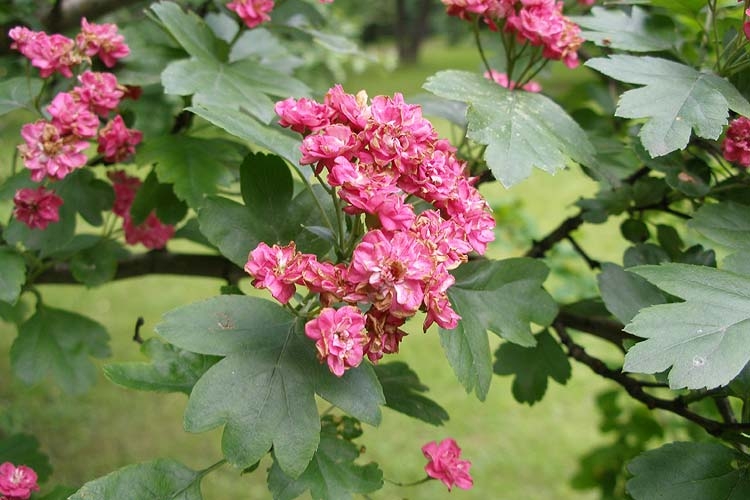Hawthorn
The Hawthorn has grown in Britain for in excess of ten thousand years and can be found the length and breadth of the land. Its name originates from the Anglo-Saxon, haegthorn, meaning hedge thorn and its other names include May (because it begins flowering during this month), Whitethorn (linked to its white flowers and the colour of its wood), Quickthorn, Quickset and simply Quick. The latter three names derive from its application to the construction of quick, or live hedges, instead of dead branches of trees. It is indeed a most practical tree for forming impenetrable barriers used to mark the boundaries of land. It is found in most parts of Europe, North Africa and Western Asia and when introduced into Australia thrived as well as in its native countries.
In size, mode of growth, foliage, colour and even odour of its flowers, the Hawthorn is perhaps more liable to variation than any other tree. When allowed its natural growth, it can attain heights of up to forty feet but on exposed outcrops may only attain six to eight feet. In May and June it is adorned with masses of fragrant white flowers which develop into small crimson haws that ripen in autumn and provide a valuable food to the feathered tribe during the severest and most protracted of winters.
Trees will typically live for one to three hundred years and in the past have been highly valued for their timber. The roots of old trees is excellent for making boxes and combs, while the wood is fine for turning and was employed for the handles of hammers, the teeth of mill-wheels, for flails and mallets, and, when heated and straightened, for canes and walking sticks. The branches and wood were used to heat ovens and for fires giving out a strong heat and, like Ash and Gorse, will burn as readily green as when seasoned. It will however spoil through inattention after cutting; if it is allowed to lie in entire logs of trunks, it soon heats and becomes brittle and worthless. The two main species of Hawthorn are the Common Hawthorn, which grows in hedgerows and on the edges of woodland, and the Woodland or Midland Hawthorn that grows within most types of native wildwood and ancient woodland.
Magically Hawthorn is a strong protective tree with strong links to the fairy realm. It is said that at twilight during the summer months, where Oak, Ash and Hawthorn grow together, all manner of fairy folk and nature spirits meet to dance a nightly celebration of Mother Nature's abundant beauty. When found growing beside sacred springs, it is said to aid access to the Otherworld and the water of such springs when drunk facilitates communication with the wild, untamed goddess of the wildwood. The flowers, which bloom at Beltane, have been used in May Day celebrations since earliest times to decorate May Poles and adorn the head of the May Queen. The berries are used medicinally to treat all manner of heart problems being a blood pressure normaliser and general cardiac tonic. In France small branches of Hawthorn were worn on the head during thunderstorms as a protection against lightning.

